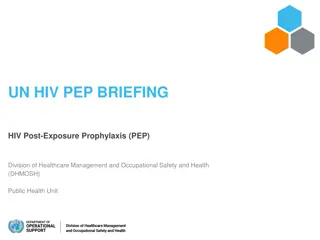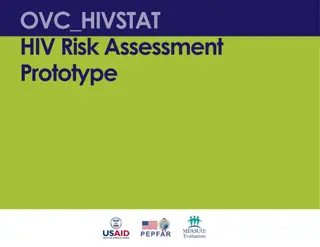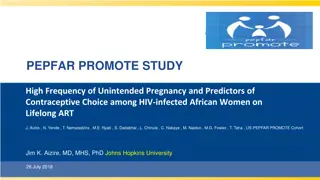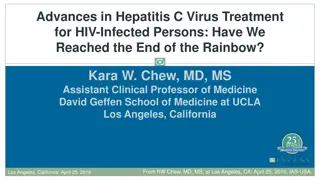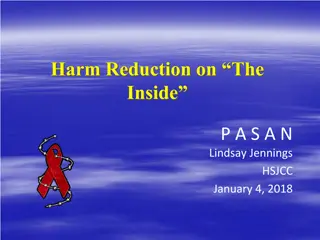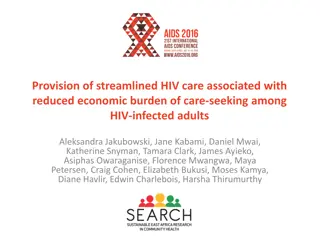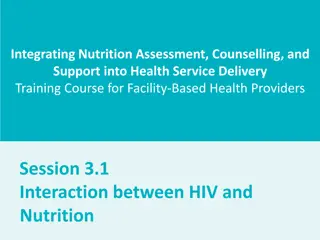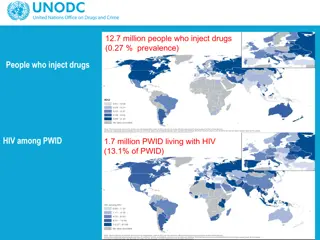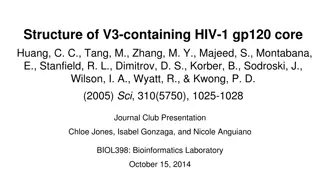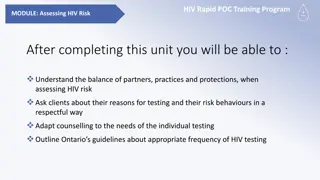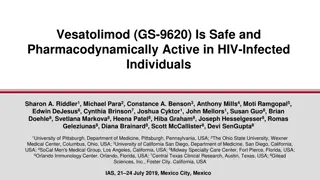Risk of HCV Reinfection Among HIV/HCV Co-Infected Individuals in Europe
In the absence of an HCV vaccine, individuals cured of HCV are still at risk of reinfection, particularly among HIV-co-infected populations. This study aims to examine the risk of reinfection within 2 years of achieving sustained virological response in Europe. Regional differences, treatment regimens, and sociodemographic factors will be assessed to understand the prevalence and variations of HCV reinfection.
Download Presentation

Please find below an Image/Link to download the presentation.
The content on the website is provided AS IS for your information and personal use only. It may not be sold, licensed, or shared on other websites without obtaining consent from the author. Download presentation by click this link. If you encounter any issues during the download, it is possible that the publisher has removed the file from their server.
E N D
Presentation Transcript
HCV reinfection among HIV/HCV co HCV reinfection among HIV/HCV co- -infected individuals in Europe individuals in Europe infected Sarah Amele Sarah Amele, Lars Peters, Alison Rodger, Linos Vandekerckhove, Thomas Benfield, Ana Milinkovic, Claudine Duvivier, Hans-J rgen Stellbrink, Helen Sambatakou, Nikoloz Chkhartishvili, Luis Caldeira, Montse Laguno, Pere Domingo, Gilles Wandeler, Robert Zangerle, Elena Kuzovatova, Gordana Dragovic, Brygida Knysz, Raimonda Matulionyte, J rgen K. Rockstroh, Jens D. Lundgren, and Amanda Mocroft on behalf of the on behalf of the EuroSIDA EuroSIDA study group study group sarah.amele.16@ucl.ac.uk Share your thoughts on this presentation with #IAS2019 #IAS2019 Share your thoughts on this presentation with
Presenter Disclosure Information Presenter Disclosure Information Sarah Amele disclosed no conflict of interest.
Background Background In the absence of a vaccine against HCV, those who have been cured are still at risk of reinfection The overall risk is generally low, however reinfection is of particular concern among HIV co-infected individuals (PWID and HIV positive MSM), and HIV negative MSM on PrEP1,2 While Directly Acting Antivirals (DAAs) can clear HCV in nearly all HIV/HCV co- infected individuals, high rates of reinfection may hamper efforts to eliminate HCV in these populations3 Important to describe the prevalence of reinfection, and how this varies depending on risk group and region 1Simmons B. Clin Infect Dis. 2015;62(6):683 94. 2Ingiliz P. J Hepatol. 2017;66(2):282 7. 3Virlogeux V. BMC Med. 2017;15(1):1 11.
Aims Aims To examine the risk of reinfection within 2 years of achieving sustained virological response (SVR) in HIV/HCV co-infected individuals in Europe To assess whether the risk of reinfection varies depending on risk group for HIV infection, HCV treatment regimen (interferon-based regimens vs interferon-free DAAs), regional differences, or sociodemographic variables
EuroSIDA EuroSIDA study study Large prospective observational cohort study with over 22,000 HIV-positive individuals South: South: Argentina, Greece, Israel, Italy, Portugal, Spain Central West: Central West: Austria, Belgium, France, Germany, Luxembourg, Switzerland North: North: Denmark, Finland, Iceland, Ireland, Netherlands, Norway, Sweden, United Kingdom East/ East/Central Central East: East: Belarus, Bosnia-Herzegovina, Croatia, Czech Republic, Estonia, Georgia, Hungary, Latvia, Lithuania, Poland, Romania, Russia, Serbia, Slovakia, Slovenia
Methods Methods - - Definitions Definitions SVR SVR: defined as a negative HCV-RNA result after treatment end date 24 weeks or later for INF-based regimens (SVR24) 12 weeks or later for INF-free DAA regimens (SVR12) Reinfection Reinfection: defined as being HCV-RNA positive, HCV genotyped or receiving HCV treatment within 24 months of SVR12/SVR24
Methods Methods - - Statistics Statistics Tested for differences in baseline characteristics between those reinfected within 2 years of SVR and not reinfected Logistic regression was used to identify risk factors associated with reinfection within 2 years of achieving SVR Potential risk factors: Potential risk factors: age, sex, ethnicity, region in Europe, mode of HIV transmission, CD4 count, CD4 nadir, HIV-RNA, AIDS, non-ADI*, HCV treatment type, year of SVR, stage of liver fibrosis , HCV genotype, previous use of cART, prior HCV treatment, HBV infection *Non-ADI: non-AIDS defining malignancy, cardiovascular disease, end stage liver disease, end stage renal disease, pancreatitis Determined by a biopsy ( METAVIR stage F3), APRI (score >1.5), hyaluronic acid (>160ng/mL), or FibroScan (>9.5kPa) test
Inclusion criteria Inclusion criteria HIV positive HCV-RNA positive Completed HCV treatment Achieved SVR12 or SVR24 24 months FU after SVR 1 HCV-RNA test after SVR during 24 months FU
Who was included? Who was included? Ever anti-HCV positive n = 9465 Ever HCV-RNA positive n = 6770 Completed HCV treatment n = 3474 Achieved SVR n = 2168 Baseline 24 months of FU after SVR n = 1045 Included 1 HCV-RNA test during 24 months of FU n = 585
Results Reinfection by treatment Treatment Overall Interferon DAA Study population 585 475 110 78, 13.3% 63, 13.3% 15, 13.6% Reinfected (10.6-16.0%) (10.2-16.3%) (7.2-20.0%) Median time to reinfection 312 days 354 days 120 days IQR: 73-421 days IQR: 116-518 days IQR: 133-524 days
Results Reinfection by region 100% 100% 90% 80% 70% 60% 50% 44% 40% 24% 30% 18% 17% 15% 15% 20% 13% 12% 5% 10% 0% Overall (585, 78) South (142, 7) Central - West (256, 46) Region (n overall, n reinfected) North (102, 12) East/Central - East (85, 13)
Results Characteristics at SVR (1) Overall n (%) 585 (100.0) 453 (77.4) 132 (22.6) 455 (77.8) 7 (1.2) 123 (21.0) 142 (24.3) 256 (43.8) 102 (17.4) 85 (14.5) 312 (53.3) 273 (46.7) 177 (30.3) 281 (48.0) Not reinfected n (%) 507 (86.7) 385 (85.0) 122 (92.4) 408 (89.7) 7 (100.0) 92 (74.8) 135 (95.1) 210 (82.0) 90 (88.2) 72 (84.7) 261 (83.7) 246 (90.1) 148 (83.6) 243 (86.5) Reinfected n (%) 78 (13.3) 68 (15.0) 10 (7.6) 47 (10.3) 0 (0.0) 31 (25.2) 7 (4.9) 46 (18.0) 12 (11.8) 13 (15.3) 51 (16.3) 27 (9.9) 29 (16.4) 38 (13.5) P-value Overall Sex Male Female White Global Majority Unknown 0.0270 Ethnicity 0.0002 Region of Europe South Central - West North East/Central - East <2014 2014-2015 MSM IDU 0.0030 Year SVR 0.0219 HIV risk group 0.1471
Results Characteristics at SVR (2) Overall n (%) 585 (100.0) 475 (81.2) 110 (18.8) 415 (70.9) 46 (7.9) 236 (40.3) 183 (31.3) 46 (7.9) 539 (92.1) 427 (73.0) 158 (27.0) Not reinfected n (%) 507 (86.7) 412 (86.7) 95 (86.4) 363 (87.5) 37 (80.4) 204 (86.4) 159 (86.9) 42 (91.3) 465 (86.3) 374 (87.6) 133 (84.2) Median (IQR) 47 (41-52) 503 (344-695) Reinfected n (%) 78 (13.3) 63 (13.3) 15 (13.6) 52 (12.5) 9 (19.6) 32 (13.6) 24 (13.1) 4 (8.7) 74 (13.7) 53 (12.4) 25 (15.8) P-value Overall HCV treatment Interferon DAA <F3 F3* G1 G2 - G4 No Yes 0.9174 Fibrosis 0.4080 HCV genotype 0.9906 cART 0.4963 Prior HCV treatment No 0.2813 Yes 47 (41-52) 514 (346-695) 47 (42-51) 546 (384-704) 0.9358 0.5787 Age CD4 count (cells/mm 3) *Either a biopsy ( METAVIR stage F3), APRI (score >1.5), hyaluronic acid (>160ng/mL) or FibroScan (>9.5kPa) test
Results Odds of reinfection aOR (95% CI) Age group 45 >45 Male Female South 1.00 0.98 (0.56-1.72) 1.00 0.46 (0.21-0.99) 1.00 3.88 (1.66-9.07) 2.13 (0.77-5.89) 4.39 (1.60-12.05) 1.00 0.86 (0.47-1.57) 0.54 (0.24-1.21) 1.00 1.74 (1.03-2.94) 1.00 1.69 (0.73-3.95) 1.00 0.44 (0.23-0.84) 1.00 2.41 (1.00-5.81) Gender Region of Europe Central - West North East/Central-East HIV risk group MSM IDU Other 500 >500 CD4 count (cells/mm3) HCV treatment Interferon DAA <2014 Year SVR 2014-2015 Fibrosis <F3 F3 0.01 0.05 0.50 5.00 50.00 Lower odds of reinfection Higher odds of reinfection Adjusted odds ratio (95% CI)
Limitations FU HCV-RNA data not available for all No data on HCV risk behaviours The number of individuals on DAAs is limited Cohort individuals not necessarily representative of all HIV/HCV co-infected individuals Majority of study are of white ethnicity unable to explore differences in reinfection based on ethnicity Differences in access to care, and patient management approaches within countries and regions Clinics may have targeted HCV-RNA testing to those at highest risk of reinfection, or with signs of reinfection
Summary The proportion of reinfections among HIV/HCV co-infected individuals within 24 months of achieving SVR was 13% Individuals from Central-West and East/Central-Eastern Europe, with a CD4 count >500 cells/mm3, and those with fibrosis F3 were found to have increased odds of reinfection Females, and those who achieved SVR 2014 were found to have a decreased odds of reinfection No evidence of a difference in the proportion of individuals that were reinfected based on treatment (interferon vs interferon-free DAA).
Discussion Active surveillance to detect early HCV reinfection (with an offer of early treatment) is essential Harm reduction services for PWID are crucial to reduce rates of reinfection Reducing the rate of HCV reinfection is urgently needed to reach the goal of elimination by 2030, especially among marginalised groups1 1World Health Organization (WHO). Global hepatitis report, 2017. 2017.
The The EuroSIDA EuroSIDA Study Group Study Group The multi The multi- -centre study group, centre study group, EuroSIDA South: Argentina: (M Losso), M Kundro, Hospital JM Ramos Mejia, Buenos Aires. Greece: (H Sambatakou), Ippokration General Hospital, Athens; G Adamis, N Paissios, Athens General Hospital "G Gennimatas". Israel: (L Tau), D Turner, M Burke, Ichilov Hospital, Tel Aviv; E Shahar, G Hassoun, Rambam Medical Center, Haifa; H Elinav, M Haouzi, Hadassah University Hospital, Jerusalem; D Elbirt, AIDS Center (Neve Or), Jerusalem. Italy: (A D Arminio Monforte), Istituto Di Clinica Malattie Infettive e Tropicale, Milan; R Esposito, I Mazeu, C Mussini, Universit Modena, Modena; F Mazzotta, A Gabbuti, Ospedale S Maria Annunziata, Firenze; V Vullo, M Lichtner, University di Roma la Sapienza, Rome; M Zaccarelli, A Antinori, R Acinapura, M Plazzi, Istituto Nazionale Malattie Infettive Lazzaro Spallanzani, Rome; A Lazzarin, A Castagna, N Gianotti, Ospedale San Raffaele, Milan; M Galli, A Ridolfo, Osp. L. Sacco, Milan. Portugal: (A Zagalo), Hospital Santa Maria, Lisbon; K Mansinho, Hospital de Egas Moniz, Lisbon; F Maltez, Hospital Curry Cabral, Lisbon. Spain: (JM Miro), JM Mir , M. Laguno, E. Martinez, F. Garcia, JL Blanco, M. Martinez-Rebollar, J. Mallolas, Hospital Clinic IDIBAPS University of Barcelona, Barcelona; S Moreno, S. del Campo, Hospital Ramon y Cajal, Madrid; B Clotet, A Jou, R Paredes, J Puig, JM Llibre, JR Santos, Infectious Diseases Unit & IrsiCaixa AIDS Research Institute, Hospital germans Trias I Pujol, Badalona; P Domingo, M Gutierrez, G Mateo, MA Sambeat, Hospital Sant Pau, Barcelona; JM Laporte, Hospital Universitario de Alava, Vitoria-Gasteiz. Central West: Austria: B Schmied), Otto Wagner Hospital, Vienna; R Zangerle, Medical University Innsbruck, Innsbruck. Belgium: (N Clumeck), S De Wit, M Delforge, Saint-Pierre Hospital, Brussels; E Florence, Institute of Tropical Medicine, Antwerp; L Vandekerckhove, University Ziekenhuis Gent, Gent. France: (J-P Viard), H tel-Dieu, Paris; P-M Girard, Hospital Saint-Antoine, Paris; C Pradier, E Fontas, H pital de l'Archet, Nice; C Duvivier, H pital Necker-Enfants Malades, Paris. Germany: (J Rockstroh), Universit ts Klinik Bonn; G Behrens, Medizinische Hochschule Hannover; O Degen, University Medical Center Hamburg-Eppendorf, Infectious Diseases Unit, Hamburg; HJ Stellbrink, IPM Study Center, Hamburg; C Stefan, JW Goethe University Hospital, Frankfurt; J Bogner, Medizinische Poliklinik, Munich; G. F tkenheuer, Universit t K ln, Cologne. Luxembourg:(T Staub), R Hemmer, Centre Hospitalier, Luxembourg. Switzerland: (A Scherrer), R Weber, University Hospital Zurich; M Cavassini, University Hospital Lausanne; A Calmy, University Hospital Geneva; H Furrer, University Hospital Bern; M Battegay, University Hospital Basel; P Schmid, Cantonal Hospital St. Gallen. North: Denmark: G Kronborg, T Benfield, Hvidovre Hospital, Copenhagen; J Gerstoft, T Katzenstein, Rigshospitalet, Copenhagen; C Pedersen, IS Johansen, Odense University Hospital, Odense; L Ostergaard, Skejby Hospital, Aarhus, L Wiese, NF Moller, Sj llands Universitetshospital, Roskilde; L N Nielsen, Hillerod Hospital, Hillerod. Finland: (I Aho), Helsinki University Hospital, Helsinki. Iceland: (M Gottfredsson), Landspitali University Hospital, Reykjavik. Ireland: (C Kelly), St. James's Hospital, Dublin. Netherlands: (P Reiss), Academisch Medisch Centrum bij de Universiteit van Amsterdam, Amsterdam. Norway: (DH Reikvam), A Maeland, J Bruun, Oslo University Hospital, Ullevaal. Sweden: (K Falconer), A Thalme, A Sonnerborg, Karolinska University Hospital, Stockholm; CJ Treutiger, Venh lsan-Sodersjukhuset, Stockholm; L Flamholc, Malm University Hospital, Malm . United Kingdom:A Milinkovic, St. Stephen's Clinic, Chelsea and Westminster Hospital, London; AM Johnson, E Simons, S Edwards, Mortimer Market Centre, London; A Phillips, MA Johnson, A Mocroft, Royal Free and University College Medical School, London (Royal Free Campus); C Orkin, Royal London Hospital, London; A Winston, Imperial College School of Medicine at St. Mary's, London; A Clarke, Royal Sussex County Hospital, Brighton; C Leen, Western General Hospital, Edinburgh. Central East: Bosnia-Herzegovina: (V Hadziosmanovic), Klinicki Centar Univerziteta Sarajevo, Sarajevo. Croatia: (J Begovac), University Hospital of Infectious Diseases, Zagreb. Czech Republic: (L Machala), D Jilich, Faculty Hospital Bulovka, Prague; D Sedlacek, Charles University Hospital, Plzen. Hungary: (J Szl vik), Szent L sl Hospital, Budapest. Poland: (B Knysz), J Gasiorowski, M Inglot, Medical University, Wroclaw; E Bakowska, Centrum Diagnostyki i Terapii AIDS, Warsaw; R Flisiak, A Grzeszczuk, Medical University, Bialystok; M Parczewski, K Maciejewska, B Aksak-Was, Medical Univesity, Szczecin; M Beniowski, E Mularska, Osrodek Diagnostyki i Terapii AIDS, Chorzow; T Smiatacz, M Gensing, Medical University, Gdansk; E Jablonowska, J Kamerys, K Wojcik, Wojewodzki Szpital Specjalistyczny, Lodz; I Mozer-Lisewska, B Rozplochowski, Poznan University of Medical Sciences, Poznan. Romania: (R Radoi), C Oprea, Carol Davila University of Medicine and Pharmacy Bucharest, Victor Babes Clinical Hospital for Infectious and Tropical Diseases, Bucharest. Serbia: (G Dragovic), The Institute for Infectious and Tropical Diseases, Belgrade. Slovenia: (J Tomazic), University Clinical Centre Ljubljana, Ljubljana. East: Belarus: (I Karpov), A Vassilenko, Belarus State Medical University, Minsk, VM Mitsura, Gomel State Medical University, Gomel; D Paduto, Regional AIDS Centre, Svetlogorsk.Estonia: (K Zilmer), West-Tallinn Central Hospital, Tallinn; Jelena Smidt, Nakkusosakond Siseklinik, Kohtla- J rve. Georgia: (N Chkhartishvili) Infectious Diseases, AIDS & Clinical Immunology Research Center, Tbilisi. Latvia: (B Rozentale), Infectology Centre of Latvia, Riga. Lithuania: (V Uzdaviniene) Vilnius University Hospital Santaros Klinikos, Vilnius; R Matulionyte, Centro poliklinika, Vilnius, Vilnius University Hospital Santaros Klinikos, Vilnius. Russia: (A Panteleev), O Panteleev, St Petersburg AIDS Centre, St Peterburg; A Yakovlev, Medical Academy Botkin Hospital, St Petersburg; T Trofimora, Novgorod Centre for AIDS, Novgorod, I Khromova, Centre for HIV/AIDS & and Infectious Diseases, Kaliningrad; E Kuzovatova, Nizhny Novgorod Scientific and Research Institute of Epidemiology and Microbiology named after Academician I.N. Blokhina, Nizhny Novogrod; E Borodulina, E Vdoushkina, Samara State Medical University, Samara. Ukraine: A Kuznetsova, Kharkov State Medical University, Kharkov; J Mikhalik, Crimean Republican AIDS centre, Simferopol; M Sluzhynska, Lviv Regional HIV/AIDS Prevention and Control CTR, Lviv. The following centers have previously contributed data to EuroSIDA: Infectious Diseases Hospital, Sofia, Bulgaria. H pital de la Croix Rousse, Lyon, France. H pital de la Piti -Salp ti re, Paris, France. Unit INSERM, Bordeaux, France. H pital Edouard Herriot, Lyon, France. Bernhard Nocht Institut f r Tropenmedizin, Hamburg, Germany. 1st I.K.A Hospital of Athens, Athens, Greece. Ospedale Riuniti, Divisione Malattie Infettive, Bergamo, Italy. Ospedale di Bolzano, Divisione Malattie Infettive, Bolzano, Italy. Ospedale Cotugno, III Divisione Malattie Infettive, Napoli, Italy. D rer Hospital, Bratislava, Slovakia. Hospital Carlos III, Departamento de Enfermedades Infecciosas, Madrid, Spain. Kiev Centre for AIDS, Kiev, Ukraine. Luhansk State Medical University, Luhansk, Ukraine. Odessa Region AIDS Center, Odessa, Ukraine EuroSIDA Steering Committee: I Karpov, M Losso, J Lundgren, J Rockstroh, I Aho, LD Rasmussen, V Svedhem, G Wandeler, C Pradier, N Chkhartishvili, R Matulionyte, C Oprea, JD Kowalska, J Begovac, JM Mir , G Guaraldi, R Paredes. Chair: G Wandeler. Co-Chair: R Paredes. Study Co-leads: A Mocroft, O Kirk. EuroSIDA staff: Coordinating Centre Staff: O Kirk, L Peters, A Bojesen, D Raben, EV Hansen, D Kristensen, JF Larsen, AH Fischer. Statistical Staff: A Mocroft, A Phillips, A Cozzi-Lepri, S Amele, A Pelchen-Matthews, A Roen. Funding: EuroSIDA was supported by the European Union s Seventh Framework Programme for research, technological development and demonstration under EuroCoord grant agreement n 260694. Current support includes unrestricted grants by Bristol-Myers Squibb, Gilead, GlaxoSmithKline LLC, Janssen R&D, Merck and Co. Inc., Pfizer Inc. The participation of centres from Switzerland was supported by The Swiss National Science Foundation (Grant 108787). The study is also supported by a grant [grant number DNRF126] from the Danish National Research Foundation. We thank the patients who participated in the study and the staff involved at the participating hospitals EuroSIDA (national coordinators in parenthesis). (national coordinators in parenthesis).





